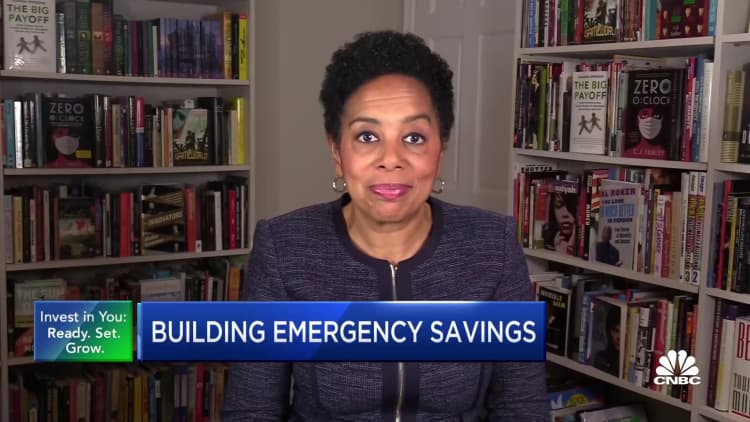Jgi/jamie Grill | Tetra Images | Getty Images
If you’re like most people, you may not have an emergency savings fund.
It’s not necessarily our fault, experts say, as our brains are programmed to focus on our needs today.
“We’re just not wired to save,” Brad Klontz, a certified financial planner and expert in financial psychology and behavioral finance, recently told CNBC.com.
He and other financial advisors typically recommend having at least three to six months’ living expenses set aside in case of an abrupt change in income or unexpected event.
Yet, research shows Americans’ cash balances often fall short of that goal. A new Bankrate survey released last week found just 44% of Americans could pay for an unexpected $1,000 expense with savings.
More from Personal Finance:
Even with interest rate cuts, 2024 will be ‘a very good year for savers’
Laid off? Experts say taking these steps can help protect your money
Why workers’ raises are smaller in 2024
Changing our instincts to spend today requires us to build new habits.
Klontz said he prefers to catch young professionals as they’re starting out, when they go from having little income as a student to feeling wealthy. At that point, it doesn’t feel like as much of a stretch to set aside 20% of your income toward retirement and 5% toward an emergency fund.
“It’s great if you can catch it early, because then it’s not painful at all,” said Klontz, who is a member of the CNBC Financial Advisor Council.
“But when you’re already stretched to the max, which most Americans are, [saving] becomes a painful exercise,” he said. “And that’s why many, many people don’t have it.”
Financial advisors often see this barrier to savings with their clients and have their own tactics for nudging clients to set aside more cash and free up flexibility in their budgets.
1. Start with building a habit
When interest rates were low, it was sometimes a tough sell to get clients to set aside more cash, admits Marguerita Cheng, a CFP and CEO of Blue Ocean Global Wealth in Gaithersburg, Maryland.
“[Now] savers are earning more interest, so it’s a lot more compelling,” said Cheng, who is also a member of the CNBC FA Council.
Still, reaching the minimum three-month threshold for emergency savings can be discouraging because it is so high.

To help combat that, she encourages clients to focus on building a habit, not on the amounts they initially start setting aside.
For example, a family may start by setting aside $10 every time the paycheck comes in.
“It sounds small,” Cheng said. “But it actually works because they can achieve that goal.”
Then, when other balances are paid down, such as a credit card or car loan, Cheng said she advises clients to put that extra money to increase their savings contributions. That way, $10 per paycheck may increase to $25, $50, $100, $200 or more, she said.
There can be some flexibility. For example, if a $425 monthly car payment comes to an end, she tells clients to put half of that sum in savings.
“It’s ok if you spend half to enjoy your life,” Cheng said she tells clients. “But what I need you to do is save the other half … so that you can enjoy your life in the future.”
2. Trim spending where you can
To free up more money to devote to savings, it also helps to cut back on discretionary spending.
Two big culprits advisors say they often see taking cash away from clients’ budgets are dining out and entertainment costs.
“The big one is cable,” said CFP Cameron Valadez, partner at Planable Wealth in Riverside, California.
By switching from a traditional cable plan that costs $250 per month to an online provider, it might be possible to cut that bill to $65 or $70 per month — extra cash that can be used to boost emergency savings, he said.
3. Revisit your insurance coverage
One monthly cost many people do not pay enough attention to is insurance, including home, automobile and other policies, according to Valadez, who is also host of the “Retired-ish” podcast.
To save on those policies, it helps to shop carriers more often, such as once a year, to make sure you’re getting the best deal, he said.
“Most people get their homeowners insurance when they buy their home, and they never look at it again,” Valadez said. “And that’s a huge mistake.”
Bundling home and auto insurance may be another way to save, he said.
In addition, policyholders may find extra savings by seeing if their current or prospective insurance carriers will offer discounts, such as for workers in civil servant positions. This may also apply to your homeowners policy if you’ve made upgrades that qualify, such as deadbolt locks, an alarm system or fire sprinklers, Valadez noted.
Once you have some emergency cash set aside, you may want to consider increasing your deductibles on these policies, which can reduce your monthly payments. But be prepared to pay a larger upfront sum if an emergency does occur, Valadez said.
By increasing your homeowners policy deductible from $1,000 to $2,500, for example, you may be able to shave 10% to 12% on your annual costs, he said.
Importantly, before making any policy changes, it is crucial to consider whether you can still financially withstand a devastating event, Valadez said.
Don’t miss these stories from CNBC PRO:

